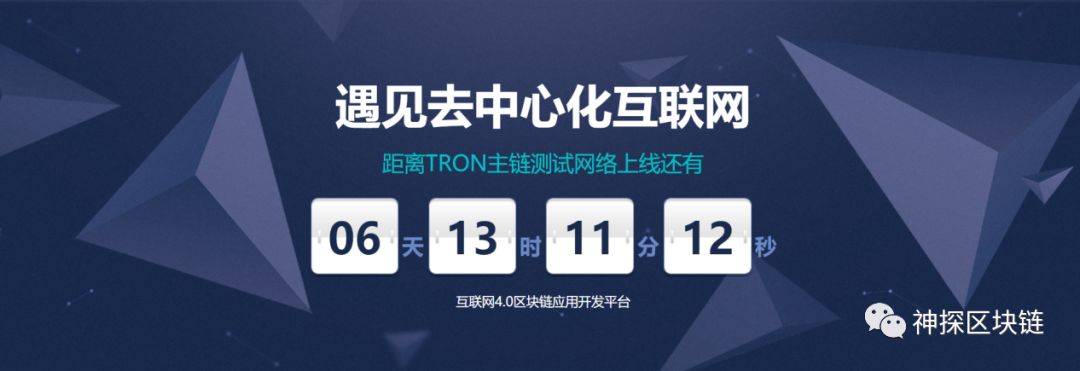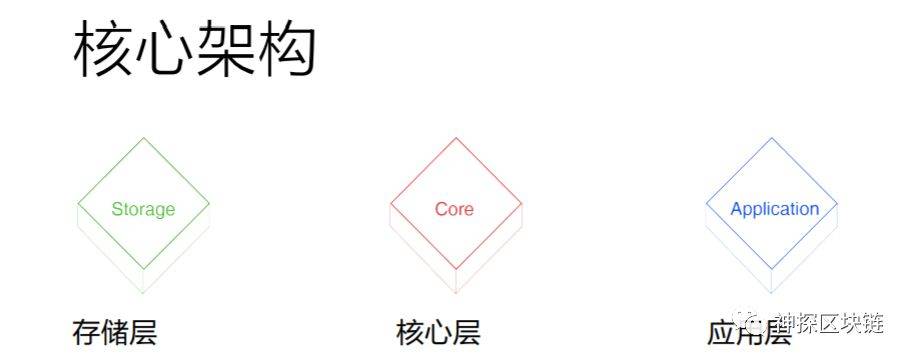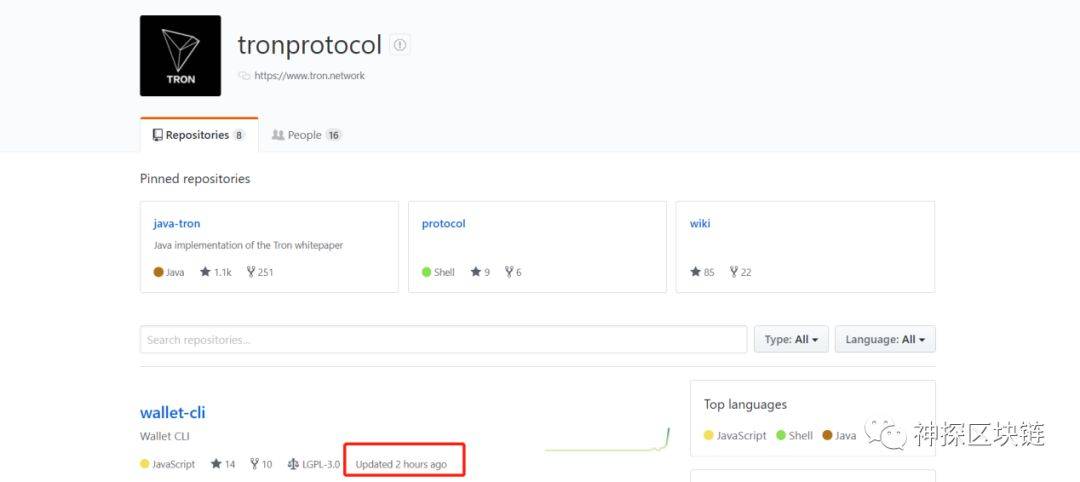88322
|
Tron will be launched on the mainnet test network on March 31, 2018. Perhaps for ordinary investors who have little understanding of technology, this is just another "good thing" released by TRON, which is extremely active on social networks. But in fact, this is a significant first step taken by the Tron project in the field of blockchain technology, and it is a decisive step. For TRON CEO Justin Sun, a star entrepreneur born in the 1990s, and the entire TRON team, this is Tron’s “Exodus”. Most investors first became acquainted with Tron in September 2017 - a period of "Black Iron Era" that will be recorded in the history of the blockchain industry. Tron, who came from a well-known family, was born at the wrong time. Until early January 2018, in just a few days, Tron became the first "100-fold coin" in 2018 and became famous as a result, quickly ranking among the top 20 digital assets in terms of market value. Since its birth, Tron has been criticized for its high-profile promotional style and grand vision that seems insufficient to be implemented. As of today, Tron’s test network is about to go online, and the previous doubts about the “air” have been overturned. This also means that Tron will bid farewell to the identity of Ethereum ERC20 token in the near future. Not only will it break away from Ethereum, but this time the mainnet will even "revolution" the "life" of Ethereum. Maybe it’s time for us to re-examine the wave field, a real wave field that focuses on technology. Before talking about technology, we must first understand the vision of TRON: TRON is an open source decentralized content entertainment platform based on blockchain. Its vision is to use blockchain and distributed storage technology to build a global free content entertainment system, and ultimately "decentralize" the Internet ecosystem. It can be seen that the vision of Tron is extremely ambitious, and the implementation of the entire system is expected to be an 8-10-year project involving 6 steps. The initial plan of Tron even reached 2029. This is also the point where Tron has received the most doubts - its grand vision and poor implementation. Looking at today's blockchain projects, there are very few people who dare to "stick to" technology and plan for the future, and are willing to build a blockchain 4.0 public chain that surpasses Ethereum. However, Tron began to conceive of the Internet form of the future world in the early stages of the project. Such people who "look up to the stars" will inevitably be regarded as unreliable in the eyes of some project investors who pursue "short, flat, and fast" returns. The release of TRON's mainnet test network is the best response to doubters and the best gift to TRON's long-term supporters. In just six months, Tron has grown from scratch. For public chain projects, the main network is the foundation of all superstructures and the "revolutionary base" of the project. The launch of the mainnet testnet is Tron's first demonstration of technical achievements to the public. This test network will include complete nodes, basic network functions, trading functions, custom asset modules, etc. Developers can deeply participate in the testing of the TRON network itself, and users without technical foundation can also participate in the testing of various products supporting the network itself, such as wallets, blockchain browsers, etc. The test network will provide very important reference data for the official operation of the TRON main network, ensure that the main network can operate stably and safely, and provide preliminary guidance and suggestions for the future development direction of the main network. Having the mainnet means that the project will get rid of its identity as an ERC20 token and begin to become a true "value token" in the TRON ecosystem. In the initial stage of "Exodus", TRON wants to achieve a multi-faceted ecosystem platform that transcends Ethereum. At the end of July 2015, the Ethereum project was officially released. Since then, the application scenarios of blockchain technology have extended from single UTXO-based digital currency transactions to the Turing-complete general computing field, opening the door to the blockchain 2.0 era. However, the progress of blockchain technology is astonishing. As the most prestigious public chain project, Ethereum has brought a new form of blockchain technology, but it also has certain shortcomings and problems, and it has ushered in many aggressive challengers in 2018. In the first phase of the project, TRON, which was targeting the blockchain 4.0 era, is one of the most powerful challengers that Ethereum will face next.  1.Design concept The initial goal of the Ethereum project is to create a smart contract platform that supports Turing-complete applications and automatically executes according to the agreed logic of the smart contract. Ideally there would be no issues like downtime, censorship, fraud, and third-party intervention. TRON's current goal is also a decentralized smart contract platform, but compared with the old Ethereum, it has the characteristics of high throughput, easy expansion, and high reliability. TRON is positioned by the team as the operating system of the future blockchain field. With the help of TRON, developers can deploy their own decentralized applications. TRON is architecturally divided into storage layer, core layer and application layer. The three levels are relatively independent and have a clear structure. At the same time, they work together to complete computing tasks efficiently and support the ecological community of the entire TRON network.  2. Consensus mechanism Ethereum initially adopted a variant consensus algorithm (Ethash) based on PoW (Proof of Work). Although this algorithm has made certain improvements based on PoW, it still requires a large number of invalid operations and is inefficient, which has been criticized by people. Ethereum currently adopts a hybrid model of PoS (Proof of State) + PoW, and plans to adopt a pure PoS consensus mechanism in the future. However, this will face other problems such as fork threats, and the complexity will also be greatly increased, which still needs further testing. TRON adopts an improved DPoS (Delegated Proof of Stake) consensus mechanism. DPoS was the earliest blockchain consensus algorithm adopted by the BitShare project. Solve the centralization problem by using the witness mechanism. A total of N witnesses sign the block, and these witnesses are voted by the subjects using the blockchain network. Since users naturally consider their own interests, users will spontaneously choose higher-performance distributed nodes that tend to be decentralized, which also greatly increases reliability. Because of the decentralized voting mechanism, DPoS is more democratic than other systems. Due to the relative concentration of nodes in DPoS, the efficiency has been greatly improved compared to the early PoW and PoS. However, DPoS also has the problem that nodes are vulnerable to manipulation or attacks. When there are nodes with huge currency holdings, the weight of the nodes can easily influence the entire network. TRON's improved DPoS consensus mechanism solves this problem very well. Under the agreement, global users spontaneously deploy TRON network nodes, and all TRON users vote to select N representative nodes. Different from traditional DPoS, the representative nodes selected by the TRON version of DPoS have equal power and work together to complete computing tasks on the TRON network, which greatly reduces the possibility of the emergence of "node oligarchs". It can be said that the improved version of DPoS on the TRON main network is a clever optimization made on the traditional DPoS. The blockchain system is first of all a distributed system. In the P2P system, nodes that do not trust each other finally reach data consistency through a preset mechanism, which is called consensus. The consensus mechanism is the method used to achieve this consensus. The consensus mechanism is the most basic and important issue in the distributed field. The first-generation blockchain projects basically adopted the PoW consensus mechanism, such as Bitcoin, but PoS itself had problems such as resource waste. Subsequent blockchain projects improved this, and new consensus mechanisms such as PoS emerged, but there were also problems. DPoS is a relatively cutting-edge and reasonable consensus mechanism for the new generation of public chains at this stage, and TRON's DPoS consensus mechanism has been optimized and improved on this basis, avoiding the possibility that TRON is superior to Ethereum in terms of consensus mechanism. 3.Smart Contract Ethereum supports the development of smart contracts through Turing-complete high-level languages, and has designed a Turing-complete high-level programming language - Solidity - for writing smart contracts. As an application running in the Ethereum Virtual Machine (EVM), smart contracts can accept external transaction requests and events, and by triggering code logic, further generate transactions and events and call other smart contracts. TRON will also implement its own virtual machine (TVM). TVM has many advantages such as lightweight, fast loading, resource isolation, scalability, etc., and supports the development of smart contracts through Turing-complete high-level languages. What’s amazing is that TRON will initially support the development of smart contracts in Java language. Java is one of the most popular high-level languages. It has a mature developer community foundation. Ordinary Java developers can access it without any threshold. In addition, Java development is highly efficient and supports many scenarios. In addition, TRON's protocol is completely defined using Google protobuf, which naturally supports multi-language expansion. TRON developers can easily use the interface to implement rich DApps and personalized wallets. In contrast, the Solidity language built by Ethereum itself has many restrictions, making it relatively difficult to implement complex logic. Smart contracts conclude and run various contracts in the form of computer programs. Since smart contracts modify network ledgers through the consensus of the blockchain network, they are "tamper-proof" and can solve many practical problems. It is the most important concept in the "public chain" at this stage. On the issue of smart contracts, TRON fully realizes all smart contract functions of Ethereum, and chooses the extremely popular high-level language - Java as the smart contract development language, coupled with the standard Google protobuf standard interface, which completely beats Ethereum in terms of smart contract flexibility and ease of use. 4.Performance and throughput Due to the inefficiency of the consensus mechanism and the limitation of the single-thread performance of the CPU in Ethereum, performance and throughput have always been one of the directions that subsequent public chains strive to improve. Ethereum’s early test network achieved 25 transactions per second (TPS) and currently maintains a level of more than 20 TPS. Due to poor performance issues, Ethereum has encountered network congestion many times in its history. Under TRON's excellent consensus mechanism, limited high-computing performance nodes are selected by users as network maintenance nodes, thereby ensuring that the TPS of the overall network is maintained above an acceptable level and achieving high throughput. In addition, according to official disclosures, the TRON network has a mechanism that can dynamically adjust the set of bookkeepers based on the speed and delay of block production. The TPS of the TRON network is initially expected to reach thousands of levels (1000+), which is expected to far exceed Bitcoin, Ethereum, etc., and may be further improved in the future. High TPS indirectly ensures the low latency of all operations on TRON, and most directly can make transfers faster, thereby enabling daily payments. In the long run, it can provide a technical foundation for developing more complex and sophisticated smart contracts and building DApps that require high-performance support. In terms of performance throughput, TRON wins. 5. Economic mechanism Ethereum adopts a leasing model, using gas to control the upper limit of a certain transaction execution instruction. Gas is exchanged with ether currency. Each execution of a contract instruction consumes a fixed amount of fuel. If the fuel is consumed before the execution is completed, the contract will be terminated and rolled back. The purpose of charging Gas is to ensure that the network does not bog down due to a large amount of intensive work. But the problem with this approach is that developers on the Ethereum network will continue to pay for fuel at various stages, which requires large fees and high volatility. If ordinary developers want to test their applications on Ethereum, the gas costs in the early stages of development are enough to bankrupt the developers. This is extremely detrimental to ecological construction and on-chain applications with complex logic. TRON has improved its economic mechanism in response to this problem and adopted a leasing model. Supports ultra-low fee transfers, and only requires 10 minus 6 TRX to complete a single transfer. And users of third-party programs do not need to pay any network fees directly, which greatly reduces the economic costs of developers, and the low handling fees are very suitable for the development and construction of the network ecosystem. TRON continues to win. 6. Security Ethereum is more vulnerable to attacks because the transactions in the network are more diverse than digital currency projects. Ethereum's core design idea in reducing attacks is still to prevent a few people from doing evil through an economic incentive mechanism: (1) All transactions must provide transaction fees to avoid DDoS attacks. (2) The number of program running instructions is limited by Gas. If the consumption exceeds the balance, it will be canceled, avoiding malicious circular contracts. Since TRON adopts an improved version of the DPoS consensus, TRON's ordinary user nodes will provide users with network bandwidth, storage space, and computing power in proportion to the owner's token amount. Therefore, malicious attackers can only consume network resources corresponding to their own TRON. In addition, it is not feasible to use centralized nodes to launch attacks, because whether to become a centralized node depends on user voting. In other words, if the perpetrator wants to use small-value transactions and other operations that occupy network resources to cause TRON network congestion, unless it can be voted to become a majority of centralized nodes, it can mobilize enough system resources to initiate massive small-value transactions to clog the network. Since ordinary user nodes are self-interested, it is almost impossible for such a situation to occur. In terms of security, the two adopt completely different effective security strategies, but TRON is superior in that it maintains security without placing additional burden on the system. 7.Extensibility Scalability is the biggest constraint for the Ethereum network to undertake more business volumes. Ethereum plans to use sharding to improve the scalability of the network, but it may still be several years before such a working system is deployed on the mainnet. Ethereum will have to move from a fully replicated global state to a sharded state. For Ethereum, which has a huge block size today, this will be an extremely difficult project to execute. Compared with Ethereum, TRON expanded the network "almost infinitely" in the early stages of the project by dividing storage, core and applications into different levels of architecture. The storage layer uses KhaosDB and LevelDB, which can realize rapid switching iteration and upgrade of the main chain. The storage layer is designed to be divided into multiple chains, each chain is responsible for processing transactions that update the shard state. The core layer of TRON combines the hashes of all shards into a Merkel tree-like structure, allowing the global state hash to be stored in the blocks of the top chain. This architecture not only ensures the smooth operation of the existing main network, but also provides a solid theoretical foundation for future TRON expansion. Although neither Ethereum nor Tron currently implements a sharding mechanism, TRON, which has prepared for a rainy day and laid out its plans in advance, is obviously better in terms of the difficulty of sharding in the future. 8. Application Since Ethereum was first released, after several years of rapid development, it has accumulated numerous DApp resources, thus bringing a large user base. However, due to performance issues, the user experience can only be described as average. And for a long time, Ethereum has not had large-scale projects that can be built on the chain, and the most widely used function is nothing more than fundraising. TRON not only focuses on the underlying technology of the blockchain, but also attaches great importance to the application experience of blockchain products. Another highlight of TRON is that based on the high-performance main chain, killer applications will be released as the main network goes online, which can be called its own ecosystem. It can be said that Tron’s public chain has its own focus at the beginning. Unlike the large and comprehensive Ethereum, Tron will definitely set up its own social and entertainment application projects on the chain in the early days. With the subsequent development of the ecology, it will turn to all-round development, which is completely consistent with the plan in the TRON white paper. The feature of having high-quality DApps will be very conducive to the promotion of the TRON mainnet, providing great possibilities for catching up from behind. In terms of application, Ethereum is temporarily ahead, but TRON is very likely to surpass Ethereum after a certain period of development after the main network is successfully launched. Obviously, TRON, as the second-generation public chain project after Ethereum, has integrated the advantages of multiple high-quality blockchain systems in the design and development of the TRON mainnet test network launched this time. Focusing on the present and looking to the future, it has indeed provided a new set of excellent solutions. TRON has delivered a satisfactory answer in just half a year. Such rapid development and progress is inseparable from TRON's values of respecting technology and the unremitting efforts of the TRON team. Many people have a stereotype about TRON, thinking that TRON focuses more on marketing and promotion. In fact, TRON is currently one of the teams that is most focused on development. Since the establishment of the project, TRON has continuously introduced technical experts and received frequent good news. Moreover, since the beginning of 2018, TRON's code update frequency has been at the forefront of all blockchain projects, and has repeatedly won the highest single-week update frequency. At the time of writing, the Github open source library of the TRON project showed that the last git push of the code was 2 hours ago:   (Comprehensive ranking in the code list ranks fourth) Tron used to be public, energetic, youthful, and full of youthful spirit, much like the post-90s celebrity founder Justin Sun. But now Tron's vigor still adds a touch of calmness. Tron, which focuses on the entertainment media ecology but whose ultimate goal is the "blockchain Internet", has launched a mainnet test network that is better than Ethereum. No one will say that it is a project that is more about marketing than technology. When facing unwarranted doubts and responsibilities, you should have more confidence. In just half a year, the Tron team has created a basic chain that integrates many of the latest blockchain technologies. Don’t forget, this is just the first step of Tron’s long-term plan - Exodus, and its power is far from coming. For TRON, which has strong capital and excellent technical strength, as long as the team continues to persevere, everything is possible. Detective Blockchain Fame and wealth are all dust Only magnanimity is always in my heart  The story of you and me in the currency circle starts with you paying attention to me The functions of the official account are gradually improved. Veterans can enter the official account and add my personal WeChat. I am willing to work with you in the currency circle and set sail for the future! ! ! |